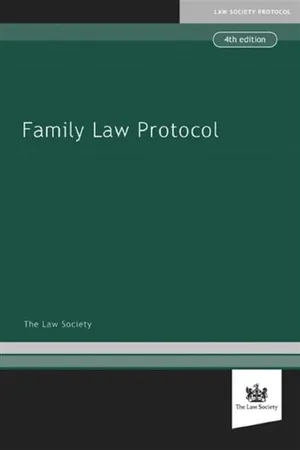About this book
This authoritative set of best practice guidelines has been comprehensively updated to cover all the changes since 2010 and includes two new chapters on forced marriage and alternative pathways to parenthood. Endorsed by the President of the Family Division, the Protocol is the standard by which members of the Law Society and Resolution are judged.The fourth edition of this indispensable book takes account of significant developments including: - the creation of the Family Court- new legislation on honour based violence, forced marriage and FGM- new procedures for non-court dispute resolution, such as arbitration and MIAMs- key changes to legal aid provision introduced by the Legal Aid, Sentencing and Punishment of Offenders Act 2012.Developed by the Law Society in association with Resolution and other leading organisations, interest groups and figures in the field, this is the essential text for family law practitioners.
Frequently asked questions
- Essential is ideal for learners and professionals who enjoy exploring a wide range of subjects. Access the Essential Library with 800,000+ trusted titles and best-sellers across business, personal growth, and the humanities. Includes unlimited reading time and Standard Read Aloud voice.
- Complete: Perfect for advanced learners and researchers needing full, unrestricted access. Unlock 1.4M+ books across hundreds of subjects, including academic and specialized titles. The Complete Plan also includes advanced features like Premium Read Aloud and Research Assistant.
Please note we cannot support devices running on iOS 13 and Android 7 or earlier. Learn more about using the app.
Information
- Acting in the Absence of a Children’s Guardian (21 August 2009)
- Attendance of Solicitors at Local Authority Children Act Meetings(9 January 2013)
- Unbundling Civil Legal Services (19 March 2015)
- Collaborative Professionals
- Correspondence
- Discussing Dispute Resolution Options
- Domestic Abuse Cases
- International Issues
- Mediation
- Referrals to Contact Centres
- Service of Documents
- Social Media
- Working with the Bar in Family Cases
- Working with Clients
- Working with Litigants in Person
- Working with Vulnerable Clients
- method of communication with the client;
- possibility of counselling being appropriate to help the client with differing emotions following a relationship breakdown;
- timescale and potential costs involved and how their case will be funded (in particular, solicitors must consider whether clients are or remain eligible for public funding (see Truex v. Kitchin [2007] EWCA Civ 618));
- if any emergency steps are needed and the options available (including safeguarding the client, children or any assets);
- how best to proceed with next steps.
- emphasise the need for parents to accept parental responsibility for their children;
- aim to promote the child’s welfare as the paramount consideration;
- encourage separation of addressing the children’s needs from those of the parents;
- encourage the use of mediation and other dispute resolution options;
- provide information about local support/guidance services;
- provide information about parenting apart.
- agreement between the parties;
- negotiation between the parties’ solicitors;
- mediation;
- collaborative law;
- family arbitration;
- court application.
- any incidents of domestic abuse, the need to screen for it and to make a risk assessment;
- civil and criminal remedies.
Table of contents
- Cover
- Half Title
- Related titles from Law Society Publishing
- Title
- Copyright
- Contents
- Foreword to the fourth edition by the Right Honourable Sir James Munby
- Preface and acknowledgements
- Table of cases
- Table of statutes
- Table of statutory instruments
- Table of international instruments
- Abbreviations
- 1 Main protocol
- 2 Non-court dispute resolution
- 3 Domestic abuse and honour based violence
- 4 Children: private law
- 5 Children: public law
- 6 Abduction
- 7 Child support
- 8 Schedule 1 proceedings under the Children Act 1989
- 9 Proceedings for dissolution, divorce, judicial separation or nullity
- 10 Financial remedies
- 11 Cohabitation
- 12 Forced marriage and female genital mutilation
- 13 Alternative pathways to parenthood
- APPENDICES
- Index
